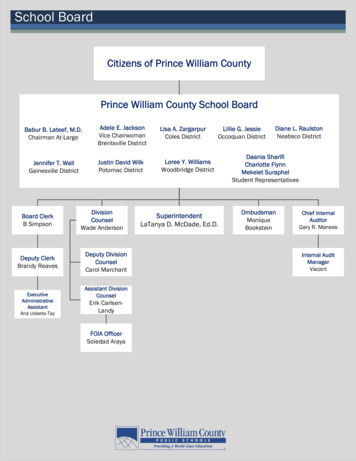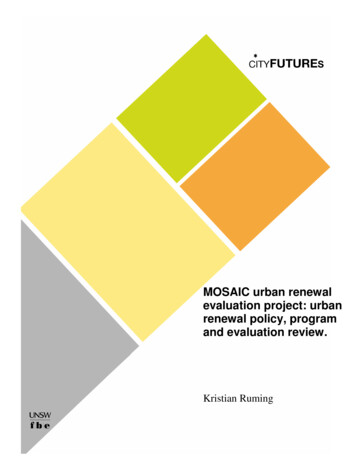
Transcription
bae urban economicsData Center Market StudyPrepared for Prince William County, VirginiaOctober 20, 2021
Executive SummaryAs part of a larger study being led by Stantec to review the potential expansion of PrinceWilliam County’s Data Center Overlay Zone, BAE Urban Economics prepared a market study ofthe data center industry. This report includes four components: 1) a data center emergingtrends review, 2) a best practices/competitive assessment of economic developmentprograms for data centers, 3) an economic impact analysis for a prototype data center, and 4)a data center demand analysis for Northern Virginia and Prince William County. Key findings ofthe report are summarized below.Data Center Industry Emerging TrendsKey findings are as follows: The exponential increase in digital communications and services, and thecorresponding demand for storing, managing, and distributing large amounts of dataand information has led to substantial growth in the U.S. data center market. Data centers, which are centralized repositories of computer servers that provideelectronic services, are a key resource for digital communications and services. More data centers are being built to meet the rising amount of data that is created andstored. The U.S. Data Center Market was valued at 8.4 billion in 2020, and isprojected to reach 13.91 billion by 2026.1 The increased demand worldwide for data centers applies to both enterprise datacenter facilities owned and operated by the company they support (e.g., Amazon WebServices (AWS), Microsoft, Google, etc.) as well colocation data centers that rent outrack space to third parties for their servers or other network equipment. The COVID-19 pandemic has boosted the global data center market as it createdincreased demand for internet-related services beginning with 2020 lockdown. Thepandemic also led to companies and governments migrating from locally hostedapplications and data to cloud services provided by data centers.1United States Data Center Market - Growth, Trends, COVID-19 Impact, and Forecasts (2021 - 2026). Retrieved 20080/united-states-data-center-marketgrowth?utm source BW&utm medium PressRelease&utm code n662p8&utm campaign 1532805 United States Data Center Market Growth%2c Trends%2c COVID-19 Impact%2c and Forecasts Report 20212026&utm exec chdo54prd1
2 The increased demand for data centers has led to large increases in the total inventoryof data centers in North America. In the second half of 2020, the total inventory ofdata centers grew by 152.9 Megawatts (MW)2 (5.9 percent) and 291.8 MW (11percent) year-over-year.3 Northern Virginia has the largest data center market in the U.S. Data centers inNorthern Virginia make up 48 percent of the primary market inventory of data centersin the U.S. Real estate researchers predict continued market strength for the Northern Virginiadata center market going forward. A large amount of pre-leasing in data centers underconstruction is contributing to supply and demand figures in 2021 and beyond. 4 Rental rates for data center space are relatively low in Northern Virginia versus othermarkets, which helps to keep demand high in the market. 5 Average power rates in Northern Virginia have consistently stayed at 5.2 cents perKWh for the last five years, whish is lower than power rates in many other data centerlocations in the U.S.6 Since power makes up 40 percent of operating costs at a typicaldata center, this is a competitive advantage for Northern Virginia. 7 High demand for data centers in Northern Virginia is reflected in recent land sales forproperties where data centers are allowed. A dwindling land supply has led to recordprice per acre land sale costs in the region; the seven most recent data center landsales had price per acre costs ranging from 425,000 to 3,020,000.8 While the International Data Corporation (IDC) estimates the average age of a datacenter at nine years old, the exponential growth in digital data, services, andGrowth in the data center real estate sector is measured in power, not square footage.3CBRE Research, “A Source of Stability: Digital Infrastructure in 2020, North American Data Center Report H2 2020.” Retrieved -American-Data-Center-Report-H2-20204Ibid.5JLL, “2020 Year-End Data Center Outlook: A Review of the Industry’s latest trends and what to expect in 2021.” Retrieved research/data-center-outlook6Ibid.U.S Chamber of Commerce, “Data Centers, Jobs and Opportunities in Communities Nationwide.” (2017). Retrievedfrom -opportunities-communities-nationwide78Cushman & Wakefield, “Data Center Update Americas: United States and Canada.” (2021). Retrieved mericas-data-center-update2
communications is forcing data centers to modernize their platforms to support morecapacity, reliability, scalability, and faster processing speed. It is generally far morecost effective to modernize the existing equipment in a data center than to relocateand build a new center.Best Practices/Competitive Assessment – Economic Development ProgramsKey findings are as follows: Data centers prioritize six key factors when selecting new sites for development: fiberconnectivity, environment, access, access to electrical power, access to water, askilled workforce, and incentives. Of these, the most critical is access to highbandwidth connectivity. The growth of the data center industry in Loudoun County beginning in the 1990s hasbeen driven primarily by the density of fiber networks. Loudoun County continues to bethe location of choice but land availability has become more limited. By proximity to Loudoun County, but also in its own right, Prince William Countyprovides companies and data center operators convenient access to the mostinterconnected network in the world, with close access to inter-continental cables inNew Jersey and Virginia Beach. Land use and economic incentives can help attract data centers, even though networkconnectivity is the most important factor for data centers when it comes to siteselection. The two main economic incentives that jurisdictions offer data centers arereduced personal property tax rates, and reduced sales and use tax rates. Compared to the other Northern Virginia counties, Prince William County has thelowest personal property tax for data centers, at 1.50 per 100 of assessed value foreligible equipment (i.e., computer equipment, cooling equipment, etc.). Combined withVirginia’s sales and use tax exemption for eligible purchases, this positions PrinceWilliam County competitively versus Loudoun and Fairfax counties. In terms of zoning ordinances, Loudoun, Fairfax and Henrico counties in Virginia allowby-right development of data centers in a range of commercial, office, and industrialzones. Fairfax County imposes additional size and design regulations for data centersin the denser nonresidential zones, while Henrico County permits by-right data centerdevelopment in all office, business, and industrial zones.3
The two factors that are becoming increasingly important for the site selection processare the availability of land and the incentives/ease of development in places withavailable land. Despite regional interest in attracting data center from other parts of Virginia andcertain locations in Maryland (i.e., Prince George’s County and Frederick County), datacenter developers will continue to seek available land in Prince William County toremain close to Loudoun County’s “Data Center Alley,” so the amount of data centerdevelopment will ultimately be determined by the availability of land.Economic Impacts of Data CentersBAE used IMPLAN, an economic modeling software package, to estimate the impacts of datacenters on the Prince William County economy. The analysis considers three types of impacts:jobs, worker compensation, and total economic output generated by data centers in PrinceWilliam County.IMPLAN models the way income is spent and re-spent in other sectors in the economy,generating waves of economic activity and job creation, sometimes referred to as the“economic multiplier effect.” Once the economic events have been entered into the model,IMPLAN reports the following types of impacts: Direct – Direct impacts refer to the set of producer or consumer expenditures. This isthe amount of spending available to flow through the local economy.Indirect – Indirect impacts are impacts of local industries buying goods and servicesfrom other local industries.Induced – Induced impacts refer to an economy’s response to an initial change (directimpact) that occurs through respending of income according to household spendingpatterns.To conduct the analysis, BAE reviewed other data center economic impact studies forinformation on typical characteristics of data centers and developed a prototype data center.This prototype is one data center building; many data center complexes in Northern Virginiahave two or three buildings similar to this prototype on their campuses. The building prototypeis 250,000 square feet, and had construction impacts of 1,100 per square foot for a total of 275,000,000. It has 28 permanent jobs with 9,000 square feet per worker. Compensationper worker, including benefits is 180,000 and total worker compensation is 5,040,000.The economic impacts from this data center prototype as described above are: With construction costs estimated at 275 million over an assumed 12-month period,would support almost 1,700 estimated direct jobs and an additional 407 indirect jobs4
at other business supporting the construction. There are also another 301 jobsresulting from worker expenditures. The indirect impacts in expenditures for construction amounts to 73 million, while theinduced impact is 44 million during the construction period. Once the data center building is operating, there would be an estimated 28 direct fulltime equivalent jobs. The demand for goods and services for the operation wouldsupport an additional 133 indirect jobs, and the expenditures of worker householdswould support 22 additional jobs. Project-related jobs (direct, indirect, and induced) would be equal to .09 percent of theCounty’s total 2019 jobs. The wages of the permanent staff, which are relatively high,are equivalent to a higher proportion of the Prince William County wage totals, 1.30percent of the current County average.Market Demand AnalysisBAE analyzed both the current supply and the likely demand for data centers in NorthernVirginia, specifically in Prince William County. According to Baxtel, a data center informationclearinghouse, there are 180 data center sites in Northern Virginia, primarily in three counties:Fairfax, Loudoun, and Prince William. 9 Most of the data centers in Northern Virginia arelocated in Loudoun County in an area known as “Data Center Alley” along the Dulles Greenway(VA 267) which includes Ashburn, Sterling and Leesburg. Prince William County currently has26 data centers, with seven another additional campuses under construction.Through conversations with data center-focused real estate representatives, data centerindustry representatives and collected real estate data, BAE makes the following observationsabout the data center market in Prince William County:1. Land prices for data center properties are rising to unprecedented heights. Land salesfor data center sites in Loudoun and Prince William counties between March andAugust 2021 ranged from 425,000 - 3.02 million per acre.2. The primary drivers for data center real estate site selection are availability of powerand access to fiber. Data center real estate specialists indicate access to reliablepower and access to fiber are the most important factors in data center site selection.9Baxtel, “Northern Virginia Data Center Market.” Retrieved from https://baxtel.com/data-center/northern-virginia5
3. State economic incentives are important for attracting data centers, but not asimportant as availability of power and access to fiber. The Commonwealth of Virginiaoffers an exemption of retail sales and use tax for qualifying computer equipmentpurchased by data centers that meet statutory investment and employmentrequirements. According to data center real estate specialists, these incentives but donot drive decisions.4. Local personal property tax rates are a factor, but they are not likely to be a primaryconsideration for data center site selection. Prince William County has the lowestproperty tax rates among the Northern Virginia counties. The County recently elected toraise the property on IT equipment with a phased increase through 2024. The impactof this change is not yet known.5. O ther serious competitors to Northern Virginia for data center investments areemerging. Other areas in the broader region, including Henrico County and otherjurisdictions in Virginia and Frederick County and Prince George’s County in Marylandare working to attract data centers. Additionally, as of 2020, Maryland now exemptssales and use tax of qualified personal property for data centers.6. The demand for data centers, particularly in Northern Virginia, is extremely strongaccording to data center specialists and industry representatives and will likely remainso for many years. Experts say there is practically unlimited demand in NorthernVirginia for data centers. The high rate of growth in the sector will continue and beabated only by the lack of land availability.IntroductionBAE Urban Economics prepared a market study of the data center industry as part of a largerstudy being led by Stantec on a proposal to expand Prince William County’s Data CenterOpportunity Zone Overlay District. Included below are the four components of this marketstudy: 1) a data center emerging trends review, 2) a best practices/competitive assessment ofeconomic development programs for data centers, 3) an economic impact analysis for aprototype data center, and 4) a data center market demand analysis for Northern Virginia andPrince William County.Data Center Industry Emerging TrendsThe exponential increase of digital communication and services, demand for storing,managing, and distributing large amounts of data and information is reflected in the growth ofthe U.S. data center market. The number of internet users and applications has been risingdramatically for decades. Commercial users, such as retail and eCommerce companies,increasingly rely on the internet to provide their services and to store data. Traditional services6
provided by brick-and-mortar businesses are going online. Consider Carvana, which istransforming how used cars are bought.10 Non-commercial users access the internet foremailing, texting, streaming videos and music, gaming, and social networking.Data centers are a key resource for digital communications and services. They are centralizedrepositories of computer servers that provide these electronic services. Consequently, moredata centers are built to meet the demand of the rising amount of data that is created andstored. The U.S. Data Center Market is valued at 8.4 billion in 2020, and it is projected toreach 13.91 billion by 2026, with a compound annual growth rate (CAGR) of 8.63 percentduring the forecast period (2021-2026).11The increased demand worldwide for data centers applies to both enterprise data centerfacilities owned and operated by the company they support (e.g., Amazon Web Services (AWS),Microsoft, Google, or Apple), as well as colocation data centers. Colocation data centers rentout rack space to third parties for their servers or other network equipment. Colocation datacenters are often used by businesses that do not maintain their own data centers, but wantthe benefits provided by data centers. 12The COVID-19 pandemic has also boosted the global data center market. Demand for datacenters has grown due to: Increased demand for internet-related services resulting from COVID-19 lockdowns,leading internet traffic upsurges between 25 and 30 percent during the periods of theinitial lockdown period (March-April 2020) worldwide, 10X times more than normalgrowth ( 3 percent per month).13 Companies and government migrating from locally hosted applications and data tocloud services provided by data centers.The pandemic prompted organizations to consider enhancing their technology infrastructure,potentially accelerating the growth of the market in the near future. COVID -19 has led to10Retail & eCommerce Transformation Leads to Data Center Boom. Retrieved from: il-to-data-centers.11United States Data Center Market - Growth, Trends, COVID-19 Impact, and Forecasts (2021 - 2026). Retrieved 20080/united-states-data-center-marketgrowth?utm source BW&utm medium PressRelease&utm code n662p8&utm campaign 1532805 United States Data Center Market Growth%2c Trends%2c COVID-19 Impact%2c and Forecasts Report 20212026&utm exec 13Diana Olick. (2021, March 9). Data center real estate is primed to boom after the pandemic forced lives online. CNBC.Retrieved from: state-reits-after-covid.html.7
increased awareness of the benefits of cloud services, as well as to increased pressure fromboards and governance entities to provide more secure and robust IT environments.Wholesale rental demand for data centers, however, did fall 11 percent in 2020, due mostlyto organizations freezing their IT budgets at the start of the COVID pandemic. However, therental rate stabilized by H2 2020 to 121 per kW/month, down from 126 per kW/month in2019.14According to a report by CBRE Research, the research arm of CBRE, a major internationalcommercial real estate brokerage, total inventory in primary markets grew by 152.9Megawatts (MW) (5.9 percent) in H2 2020 and by 291.8 MW (11 percent) year-over-year.(Note: Growth in the data center real estate sector is measured in power, not square footage.)Construction capacity in the primary markets grew by about 84.2MW in H2 2020 from H1totaling 457.8 MW, an increase of 182.9 MW from 2019. The following figure shows thedemand (absorption) against the supply under construction for the primary and secondarydata center markets in the U.S. 15Figure 1: Demand (Net Absorption) vs. Supply Under Construction 2020 forPrimary & Secondary MarketsThe following tables provide a snapshot of the fundamentals of the data center real estate forthe primary and secondary markets in the U.S., which includes year-to-year change for thevarious key factors. 16CBRE Research, “A Source of Stability: Digital Infrastructure in 2020, North American Data Center Report H22020.” Retrieved from rican-Data-Center-Report-H2-2020141516Ibid.Ibid.8
Table 1: 2020 Primary Markets FundamentalsTable 2: 2020 Secondary Markets FundamentalsKey trends from CBRE’s market survey include: 17 Data centers continue to be one of the fastest growing real estate sectors prepandemic and remained strong in 2020 as government agencies and businessesreconfigured their digital infrastructure to improve their remote work capabilities, andtech giants and cloud service providers raced to meet consumer and corporatedemand. The CBRE data shows 329.6 MW of net absorption in 2020 across the seven primaryU.S. data center markets: Northern Virginia, Dallas, Silicon Valley, Chicago, Phoenix,New York Tri-State and Atlanta. While down 11 percent from the peak in 2019, 2020absorption was still higher than any other year on record. Meanwhile, vacancy at datacenters fell to just 8.5 percent, despite an 11 percent growth in new supply. The handful of data center real estate investment trusts (REITs) were among thehighest-performing in the REIT sector in 2020. They ended the year up 21 percent.Major names include CoreSite Realty, CyrusOne, Digital Realty, Equinix and QTS RealtyTrust.1817Ibid.18Diana Olick. (2021, March 9). CNBC.9
Strong demand and an uptick in investor interest in direct investment due to thestrong performance of data center REITs in 2020 resulted in a 457.8-MW data centerconstruction pipeline in the primary markets, up 62 percent from the end of 2019.More than half of the current pipeline is pre-leased. The importance of network connectivity/bandwidth and availability of power cannot beoverstated for developing high-quality, robust data center capacity.Figure 2 illustrates the historical trend of the Data Center Primary Markets fundamentals. 19Figure 2: 2015 - 2020 Primary Markets FundamentalsO t her Data Center MarketsFor comparison purposes, the following figures summarize key data f or four (4) of the primarydata center markets outside of Northern Virginia: Atlanta, Chicago, Phoenix, and Silicon Valley.2019Ibid.20Ibid.10
Figure 3: Atlanta Market Data and TrendsFigure 4: Chicago Market Data & Trends11
Figure 5: Phoenix Market Data & TrendsFigure 6: Silicon Valley Market Data & Trends12
N o rthern Virgi nia Emerging T rendsNorthern Virginia continues to be the largest data center market in the United States. (It is alsothe largest data center market in the world through 2020.21) As shown in Figure 7 below, datacenters in Northern Virginia make up 48 percent of the primary market inventory of datacenters in the United States. The next largest market for data centers in the United States isDallas/Ft. Worth which has 13 percent of the primary market inventory. According to CBRE,historical supply growth of data centers, including what is under construction, preleased, ornewly delivered, remained relatively high through 2020. Overall demand outpaced new supply,keeping the vacancy rate less than 8 percent. 22Altogether, according to Jones Lang LaSalle (JLL), another international commercial real estatebrokerage, the Northern Virginia data center market added 380 MW of single-tenant inventoryand 230 MW of multi-tenant inventory in 2020. The Northern Virginia market had 323 MW ofnet absorption in 2020 with social media accounting for 176 MW or 54 percent of that. 23Figure 7: Percentage of Primary Market InventoryNorthern Virginia Technology Council, “The Impact of Data Centers on the State and Local Economies of Virginia.”Retrieved from: https://www.nvtc.org/NVTC/Insights/Resource Library Docs/2020 NVTC Data Center Report.aspx.21CBRE Research, “A Source of Stability: Digital Infrastructure in 2020, North American Data Center Report H22020.” Retrieved from rican-Data-Center-Report-H2-2020.22JLL, “2020 Year-End Data Center Outlook: A Review of the Industry’s latest trends and what to expect in 2021.”Retrieved from arch/data-center-outlook.2313
All of the real estate research providers predict continued market strength for the NorthernVirginia data center market in 2021. In its 2020 H2 data center market report, CBRE notedthat a large amount of preleasing in the second half of 2020 will contribute to strong supplyand demand figures in 2021. Additionally, CBRE reported 12 land transactions in NorthernVirginia in 2020, which has contributed to a dwindling supply of available land. 24Rental rates in the Northern Virginia market are relatively low compared to other markets. Forexample, rental rates for sub 250 KW space is 125 on the low side and 180 on the highside in Northern Virginia, which is lower than several other U.S. markets, including Atlanta,Austin/San Antonio, Dallas/Ft. Worth, Denver, New York, Northern California and Phoenix.25Average power rates in Northern Virginia have consistently stayed at 5.2 cents per KWh for thelast five years. Again, this rate is lower than power rates in many of the data center locations inthe U.S. including Austin/San Antonio, Boston, Chicago, Denver, Houston, Los Angeles, NewJersey, New York, Northern and Southern California, and Phoenix. 26 Since power makes upapproximately 40 percent of the operating costs of a typical data center, Northern Virginia’srelatively low power costs are a competitive advantage versus other markets. 27 Prince WilliamCounty is primarily served by Northern Virginia Electric Cooperative (NOVEC), whose averageindustrial (vs. residential or commercial) power price is 6.66 cents per KWh. 28 Loudoun Countyis primarily served by Dominion Energy, whose average industrial power price is 6.05 cents perKWh.29Jones Lang LaSalle (JLL), an international real estate brokerage, offers the following marketoutlook for data center users in Northern Virginia: Historically low rental rates and additional concessions;Still many high-quality options for users to consider; andCompetition for users will stay strong for the foreseeable future3024CBRE Research.25JLL.26Ibid.U.S Chamber of Commerce, “Data Centers, Jobs and Opportunities in Communities Nationwide.” (2017). Retrievedfrom gy.com, Northern Virginia Electric Cooperative Rate & Electric Bills. Retrieved ginia-electric-cooperative/.29FindEnergy.com, Northern Virginia Electric Cooperative Rate & Electric Bills. Retrieved rgy/.30JLL.14
For data center providers in Northern Virginia, JLL’s market outlook is as follows: Margins for providers are decreasing because of aggressive new competitors;Large hyperscale deployments on land owned by the providers is at historic highs; andProviders must be more flexible with users and offer more services and betterconnectivity options to the cloud.31As noted above, there were several major site sales in Northern Virginia for data centers.Seven (7) of the most recent site sales, included in Table 3 below, document the increasingprice per acre that is the result of dwindling land inventory for data centers. 32Table 3: Northern Virginia Recent Site SalesSource: Cushman & Wakefield, 2021.Data center real estate specialists contacted for this study indicate that the biggest marketchallenge for Northern Virginia going forward is likely to be the lack of available developmentsites. Ashburn, which is home to about 80 percent of the data centers in Northern Virginia, nolonger has any available land sites, short of some limited redevelopment options. Given thoselimits, data center providers have been focusing on the next best option, which is Manassas.At this juncture however, the data center real estate specialists stress there are actuallyrelatively few land sites left in Manassas.One concern sometimes cited is the risk of data center obsolescence. Industry researchcompany International Data Corporation (IDC) puts the average age of a data center at nine (9)years old. However, the exponential growth in digital data, services, and communications isforcing data centers to modernize their platforms to support more capacity, reliability,31Ibid .32Cushman & Wakefield, “Data Center Update Americas: United States and Canada.” (2021). Retrieved mericas -data-center-update.15
scalability, and faster processing speed. It is generally far more cost effective to modernizethe equipment in a data center than to relocate and build one from scratch.Data center real estate specialists also indicate that the pandemic has had minimal effect onthe Northern Virginia data center market. If anything, there has been an acceleration of thedata center market because it has caused a lot of smaller corporations to shift their workloadto the cloud or to a more virtual environment, thereby increasing demand for data centers. Thepandemic has had some impact on construction; the real estate community say they arebeginning to see slight delays in construction, perhaps a month or two because of construct ionsupply issues.Finally, data center real estate specialists see Maryland’s recent movement in encouraging thedevelopment of data centers as possible preparation for Northern Virginia reaching datacenter capacity limits. First, in 2020 the Maryland General Assembly established an exemptionfrom Maryland sales and use tax on the purchase of qualified data center personal propertyfor up to 20 years. Then, in June 2021, Quantum Loophole, a data center developer, and TPGReal Estate Partners announced the purchase of a 2,100-acre property in Frederick County,Maryland for data centers. The site, which is located approximately 26 miles from Ashburnacross the Potomac River, is a former manufacturing site for Alcoa. The CEO of QuantumLoophole, Josh Snowhorn, indicates that that the reclaimed site has “the entitlement, power,water and proximity to Northern Virginia that the Internet industry needs for success.” Withland costs at less than 50,000 per acre compared to 400,000 per acre in NorthernVirginia, the Frederick County site has the potential to offer a lower cost alternative for datacenter providers and users. 33Best Practices/Competitive Assessment – Economic DevelopmentProgramsThis section provides an overview of best practices that state and county governments use toattract and retain data centers in their jurisdiction, assessing the extent to which thesepractices are helping other jurisdictions compete with Northern Virginia. As noted in above,Northern Virginia has by far the most data centers of any region in the United States. Theregion is a leader in establishing best practices for promoting by-right development of datacenters and extracting community benefits from the industry. However, some of the assetsand best practices that have propelled Northern Virginia to become th
about the data center market in Prince William County: 1. Land prices for data center properties are rising to unprecedented heights. Land sales for data center sites in Loudoun and Prince William counties between March and 2. The primary drivers for data center real estate site selection are availability of power and access to fiber.










